
RETURNING to a well-worn route in my experience, 5th Avenue. Five happens to be my favorite number for some reason, as I have spent considerable time on 5th Avenue. Not so much the fabled “Queen of Avenues,” home to St. Patrick’s Cathedral in Manhattan and the parade every March 17th and its dwindling collection of upscale emporia (as well as its classic lampposts, both Deskeys and Twins), but the more modest one in Brooklyn, the spine of the long corridor between Flatbush Avenue and the Narrows.
When I was a boy, the family shopped on the X-Y axes of 5th Avenue and 86th Street; I rode the B63 5th Avenue bus to high school and then college (when I didn’t take the subway). Did you know Pittsburgh has a lengthy 5th Avenue, and Chicago also has a prominent 5th Avenue, though no other numbered avenues? No doubt you have also had a 5th Avenue candy bar.
5th Avenue in Brooklyn is merely one of a sequence of numbered avenues in western Brooklyn that run from 1st to 28th Avenues. While some like 4th Avenue and 22nd Avenue (later Bay Parkway) were wider and more heavily trafficked, avenues such as 3rd, 5th, 8th, 13th and 18th came to have lengthy commercial sections, and so attracted transit systems: horsecars, then streetcars, elevated trains, and buses; today, only the buses remain, as well as the 4th Avenue BMT subway, opened in 1916.
I once again walked 5th Avenue in Park Slope from Flatbush Avenue. This time I got as far as 19th Street as it was my intention to turn south through Windsor Terrace (I will get to the results of that turn on another day in FNY). I was surprised to discover my most recent trip there had been in late 2000; I thought it had been earlier than that. The gentrification, or upscaling, of 5th Avenue in Park Slope continues apace. When I rode the bus every day here from 1971-1980, it was a gauntlet to be gotten around as it was still in the throes of its mid-1960s depression and was dangerous in spots. Park Slope’s revival happened from its richer sections near Prospect Park, beginning in the late 1970s, and spread west; today, it’s Gowanus Canal’s turn to become luxury.
Since today’s batch of photos came to about 100 and I have begun to avoid composing very long entries as the TLDR (too long don’t read) syndrome continues to take hold, I’ll split 2024’s 5th Avenue entry into two parts, with the next one coming the following week.

The north end of 5th Avenue at Flatbush Avenue is dominated by the Barclays Center, a sports and entertainment arena that is the centerpiece of Pacific Park (renamed, mystifyingly, a few years ago from Atlantic Yards, a name that made more sense because the residential buildings will eventually stand atop the Long Island Rail Road yards south of Atlantic Avenue). The arena opened in November 2012, on the heels of the passage of Hurricane Sandy.
In 2005, FNY had an item called Before Ratnerville (named for the complex’s original developer, Bruce Ratner) about the former buildings that would be lost when Pacific Park was built. Today, the former residents have scatted (most received large payments for their seized property), the furor has died down, and construction slowly continues; however, journalist Norman Oder’s groundbreaking work on the complex’s evolution continues as part of his Atlantic Yards/Pacific Park Park Report. A look at Street View will give you an idea what the area looks like recently. The current majority owner is Chinese government-owned Greenland USA.
Needless to say the north end of 5th Avenue didn’t look like this when I first rode the bus here in the Swinging Sixties. As a matter of fact it was Brooklyn’s meatpacking and slaughterhouse district. Let me here repeat a section from FNY’s first page on 5th Avenue from 2005:
We are looking at Fifth Avenue’s northernmost end, at Atlantic Avenue, in 1962 and 1978. Atlantic Avenue between 5th and 6th Avenues and Fort Greene Place between Atlantic Avenue and Hanson Place is the former Brooklyn meatpacking district; here, big names in the industry such as Swift and Armour packed poultry and meat products and if I’m not mistaken, there were slaughterhouses here as well. On those rare occasions when I walked to and from high school from here in the Super Seventies (about 6-7 blocks to the east on Washington Avenue) I would have to avoid huge hunks of beef swinging on meat hooks. Unfortunately during the 1970s I didn’t usually carry a camera. The platforms of the Long Island Rail Road Flatbush Avenue terminal are under the street.
By 1980 the last of the meat houses was gone. In the 1978 photo, the buildings on the north side of Atlantic Avenue (one marked “J. Rabinowitz & Sons” and the railroad trestle, a last remnant of an LIRR elevated extension to the Fifth Avenue El, would soon vanish and the entire block would remain empty and derelict for over twenty years until a new LIRR terminal and Target Center were constructed.
This building, in the triangle of 5th Avenue, Flatbush Avenue and Dean Street, was once the flagship of Triangle Sporting Goods, named for the shape of its original building. Besides sporting goods, it was also an official Boy Scouts outfitter, and that’s how I remember it from its Bay Ridge branch at 5th Avenue and 83rd Street, where I (or rather, my parents) purchased my Cub Scout uniforms (blue and gold) and other paraphernalia. I joined two societies as a boy: the secular Cub Scouts and the holy altar boys. Getting up to serve the 5 AM Mass builds character.
Today, the vacated building serves as a billboard, in April 2024 for Savage x Fenty, Rihanna’s new apparel endeavor.
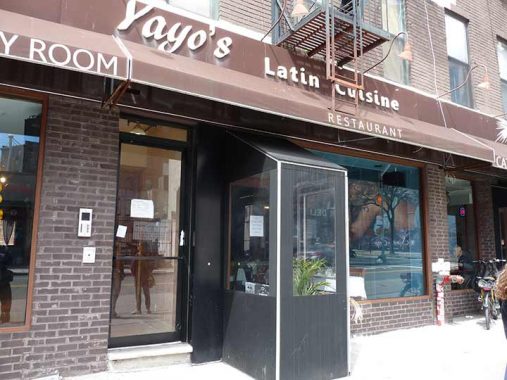
Throughout my years on upper 5th Avenue, there’s been a constant: I’m happy to see the El Viejo Yayo (“Old Yayo”) restaurant, now called Yayo’s Latin Cuisine, still going strong between Bergen and Dean Streets. It was established in the early 1960s. Yelp reviews are up and down. There’s an El Viejo Yayo in Ozone Park, but not sure if it’s the same management.

McMahon’s Public House was a former “old man bar” called O’Connor’s. This Fifth-xture between Bergen and Dean since the 1930s gained an awning, replacing an old-time calligraphic sign that had been there since the 1970s. Wendy Mitchell, in New York City’s Best Dive Bars, observed: “O’Connor’s has made the leap from hard-drinking old-man bar to hipster paradise .. now that the crowds are here, the place can become packed on weekends, but at off-times it still maintains a bit of its old man Brooklyn appeal.” Last I looked, there was karaoke, which, as an old man now, I have never participated in.

I liked this old school Brooklyn Hardware sign at #64 5th Avenue between St. Mark’s Place and Bergen Street. (5th Avenue is where a good number of east-west streets change names; for example, St. Mark’s Place becomes St. Mark’s Avenue east of 5th Avenue.) This sign is considerably faded from its original appearance in Street View in 2009, when the “Brooklyn Hardware” letters were in blue, yellow and red.
Pictured on the sign are a can of paint, a key and a deadbolt lock, saw, tape measure and socket wrench.

Pizza Secret, SW corner of 5th Avenue and St. Mark’s Place, claims to have “one of the oldest brick ovens in New York City and USA.” Maybe that’s the secret. Yellow (or gold) and black is an unusual decor choice for a pizzeria, which usually have a combination of Italian flag colors of red, white and green, but it’s one of my favorite color combinations. I kept the tiling in my bathroom when I bought my apartment — black and yellow.

I don’t know how long it’s been since Conservation Plumbing & Heating Co. has been at #71 5th Avenue, but it’s now occupied by a clothing store, Slope Vintage. A trend in gentrifying areas is to leave older signs from previous businesses in place and even renovate them, as is done by Noble Signs in East New York. I believe this sign, in blue and white in the Clarendon font, is in its original unrenovated condition.

Speaking of fonts, I was attracted to the signage at Nacho Macho Taco, which was done in classic Egyptian Bold, one of a family of slab-serifed fonts along with Clarendon. I first took notice of Egyptian Bold in the 1960s when it was used in headers for Boy’s Life Magazine. I was actually more interested in the typography than the magazine content, which usually was heavy on Scouting and outdoor activities and camping, far from my Brooklyn existence. Boy’s Life is now more upfront about its relationship with Scouting, as it was retitled Scout Life.
I was saddened to see that Miss American Pie and its vintage-look 40s-themed signage closed in the summer of 2024, after I got these photos in April. I am a pie aficionado, even the mass produced stuff like Hostess (I gave them up when they changed the recipe and made them sweeter) and Drake’s (I gave them up when I got stricter about my A1C and cholesterol counts).
BK Reader mentions Miss American Pie’s troubles, as well as other local businesses’ in the face of encroaching franchises on upper 5th Avenue.
The title comes from Don McLean’s 1971 hit record about his disillusionment with rock and roll and the USA in general.
I’ll still have pie on special occasions, and the nearby Four and Twenty Blackbirds on 3rd Avenue and 8th Street is still going strong.

I was familiar with Eastern District, a gourmet cheese and charcuterie shop, in its Greenpoint incarnation on Manhattan Avenue and I see it has added a location at #90 5th Avenue, near Warren Street. However, the Greenpointshop has changed its sign so the 5th Avenue location is the only place you can see the original Greenpoint typefont on the awning.

Some of the corner buildings on 5th Avenue, like this one at Warren Street, allow a look south on the avenue. But that wasn’t always the case, at least on all the floors. As I explain in another item from 2005:

The Fifth Avenue El, seen here in 1909 at 5th Avenue and 10th Street, was originally known as the Brooklyn Union Elevated Railroad and opened in 1889. Trains coming over the Brooklyn Bridge from Park Row would snake over el structures covering Adams Street, Myrtle and Hudson Avenues, then down Flatbush Avenue, turning onto Fifth. The el turned west for 2 blocks on 37th Street and traveled down 3rd Avenue, terminating at 65th Street; a small plaza called Stedman Square marks the terminal. Another branch turned east down 38th Street, branching into the West End el (New Utrecht Avenue) and Culver el (McDonald Avenue). The Fifth Avenue ceased operations in 1940, orphaning the Culver connection; it operated as a shuttle from 9th Avenue beginning in 1956, when the Culver el was connected to the IND tunnel ending at Church Avenue. Fifth Avenue El stops were at St. Marks Avenue, Union Street, 3rd Street, 9th Street, 16th Street, 20th Street, 25th Street, 36th Street, 40th Street, 46th Street, 52nd Street, 58th Street and 65th Street. (Above picture from Brian Merlis and Lee Rosenzweig’s Brooklyn’s Park Slope: A Photographic Retrospective)
It’s easy to say that the BMT 4th Avenue subway a block away put the Fifth Avenue El out of business. But the 4th Avenue was built in 1915-1916 by the same company that operated the Fifth Avenue, and the two lines coexisted profitably for almost a quarter century. Possibly, the Great Depression sounded the el’s death knell. Almost immediately after the el’s demise, its pillars along Third Avenue were employed to carry the roadbed of Robert Moses’ new Belt Parkway (assuring that Third Ave. would continue to be in the shadows –which would be extended all the way to Hamilton Avenue!) In the early 1960s, these el remnants would disappear as well, as the Belt in Sunset Park would be reconfigured as the Gowanus Expressway, leading to the new Verrazzano Bridge.
1924 BMT map showing Fifth Avenue El. The Fifth Avenue can be seen toward the bottom of the map.


Storefront churches, left over from pregentrification, still dot upper 5th Avenue. The “Old English” lettering on the latter is reminiscent in what you will find in Bibles and prayer books from decades ago.

This group of storefronts at 5th Avenue and Baltic Street, once called the R&A Discount Clothing Center, have been shuttered behind metal gates at least since 2011.
The first sign, to me at least, that 5th Avenue was “coming back” was when Butler Street was demapped and this giant Key Food and its parking lot were built in the roadbed in the early 1980s. the rise of grocery delivery services apparently made it redundant and it was recently torn down. Rising in its place is #120 5th Avenue, a mixed-use building that will combine commercial spaces on the ground floor and apartments on the top floors, some of which are tabbed “affordable,” and ever-shifting term. As a rule, the city’s definition of “affordable” is pricier than my own.

The way streets are named and laid out in Brooklyn has always fascinated me. East of 5th Avenue, Baltic Street is called “Park Place,” and Warren Street becomes “Prospect Place,” both named for Brooklyn’s giant Prospect Park. Most of the east-west streets beginning at 5th Avenue are lengthy indeed and go east for miles to the Crown Heights-East New York border at East New York Avenue. Despite this, they’re called “Places,” a moniker usually reserved for short, one or two-block streets.

Shingle signs that hang over sidewalks in various sizes have become frequent in gentrified areas; we have seen one earlier at Miss American Pie. Many of these signs are cleverly designed and you can even find historic hints in some.

The sun was striking this collection if attached brick walkup apartment buildings on 5th Avenue just north of Douglass Street. just right and the camera was drawn to them. Not just any brick buildings: look at the detail and ornamentation the builders were able to generate on these brickfronts.
Speaking of street patterns and naming practices, I became fascinated by the two “D” streets, Douglass and Degraw; both have fascinating stories, which FNY discussed on this page.
A proven way to get attention (as the FDNY knows) is to use red, or at least bright maroon, in your signage as a laundromat, wine shop, pizzeria and flower shop also well know.
Just east of Sackett are a couple of fascinating storefronts. Julien Boulangerie [Bakery] at #186 has signage that resembles chalked lettering, even though it’s an intricate paint job. The bakery is known, as you may expect, for croissants. As architects build housing and offices that are glassier and blander, store signage has gotten more imaginative.
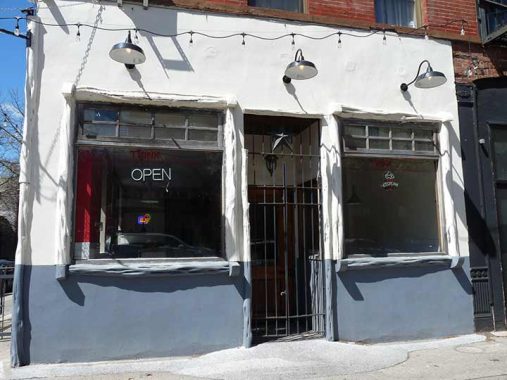
Next door at #188, corner of Sackett, is Think Ice Cream, which takes signage minimalism to near extremes. The incandescent lighting over the door is also a trend; several storefronts shown above also employ it. Minimalism in signage is a design theory that implies the business is known best by the locals, and if you wander in and enjoy the goods, you’re in the “in crowd” of aficionados who know what outsiders don’t.
Something Else at 5th and Union is hard to pin down from its signage. Like Alice’s Restaurant, you can seemingly get anything you want. That aspect aside, I think I can detect a signature style when I see one and this sign bears the earmarks of Noble Signs references above. If my guess is correct, let me know in Comments.
Both Union Street and the next major cross street, 9th Street, feature banks or former banks at the SE corner. This Manufacturers Trust Building is awaiting redevelopment or demolition. Its descendant, JP Morgan Chase after a series of mergers and acquisitions, has been my bank since 1984. My mother was employed by the bank when it was called Manufacturers Hanover Trust, or as Mets broadcaster Ralph Kiner called it, “Manufacturers Handover.”
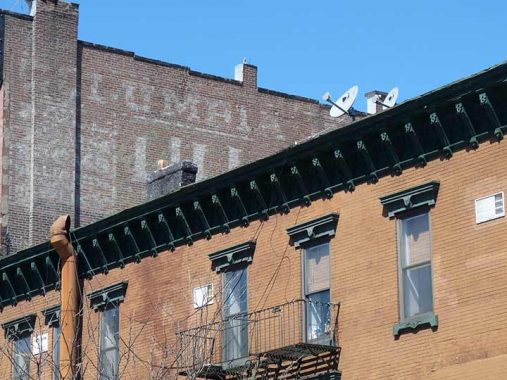
This painted ad on Union Street west of 5th is mostly invisible unless you’re on the roof. It likely dates to the 1880s. I can make out one word, “Columbia.” Columbia Soups was a popular brand when this ad was painted.
The reliable Frank Jump has the answer: Columbia Hall and Lillianette Cigars

The name of this Italian restaurant at #200 5th near Union replaced one of the “pioneers” of upper 5th when much of it was still dark and desultory, appropriately named 200 Fifth. The name also reminds me of Black Oak, Arkansas and the southern rock group featuring “Jim Dandy” Mangrum named for it.

Relatively new bookstore on 5th Avenue featuring romantic novels. You don’t see a lot of pink storefronts. A “bodice-ripping” movie or novel is one that is set in the past and that includes a lot of sex scenes. In fashion, a bodice is the top part of a dress.

Out of the corner of my eye I saw this tiny building at#668 President, just off 5th. Despite the name it seems to be a gym mainly for adults. To my trained eye it seems like yet another sign by the aforementioned Noble Signs. The building existed in the 1940s when it was a real estate office.
5th Avenue Shoe Repair, #231 5th between President and Carroll, has mixed reviews on Yelp, but you be the judge. It seems to be concentrating on watches, at least going by the window display.
I was reluctant to convert to IPhones as I did in 2015; I’m now on my third. But since I did, I stopped wearing a watch. For years in the 1990s-2000s I used a Mickey Mouse watch I picked up on the sidewalk on Sanford Avenue in Flushing.

Across the street is this Greek restaurant. I noticed the signage font immediately; it’s Bernhard Modern, the same font used on TV’s Twilight Zone (1959-1964) and its reboot with Jordan Peele a few years ago.

This storefront, #252 5th Avenue at Carroll, is a complete mystery as I can’t find any references; it’s apparently an apparel shop. The colored dots on the sidewalk sign remind me of the ones on the Wonder Bread wrappers.

I’ll kick it in the head for this segment by mentioning this chiseled street sign on Macomb Street and 5th Avenue. Where’s Macomb, you say? Macomb Street, running between 4th Avenue and Prospect Park West, was probably named for Alexander Macomb Sr. (1748-1831), a prosperous Revolution-era merchant born in Belfast, Ireland. Though he initially had Tory sympathies he built the mansion George Washington occupied in NYC between 1788-1790 when the US Capitol was located in Manhattan. Macomb owned vast upstate tracts.
Macomb Street was renamed Garfield Place after the US President James Garfield‘s assassination in 1881, which marks the chiseled sign, and the building it’s on, as particularly elderly. Garfield was not initially killed by the bullet’s impact, but by treatment with unsterilized instruments, resulting in blood poisoning.
Next time: continuing south on 5th Avenue
As always, “comment…as you see fit.” I earn a small payment when you click on any ad on the site. Take a look at the new JOBS link in the red toolbar at the top of the page on the desktop version, as I also get a small payment when you view a job via that link.
9/1/24


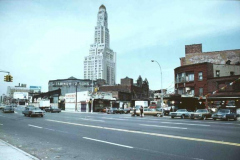
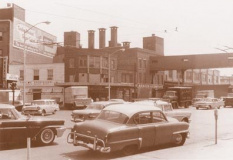
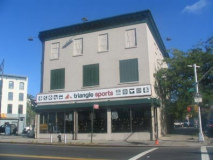
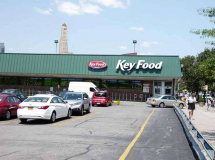
6 comments
It may be apocryphal, but the story goes that a reporter once asked Don McLean about the “meaning” of American Pie. His answer: “It meant that I’d never have to work another day in my life!”
Frank Jump’s Fading Ad Blog has a good shot of the wall ad at 5th Avenue and Union Street: Columbia Hall/Lillianette Cigars. Looks like there may have been another advertisement on the wall as well. But, the ca. 1940 tax photo shows that the entire wall was a Fletcher’s Castoria ad: Fletcher’s on 725 Union Street. So, when and/or why did the Lillianette ad come about?
Re: Ralph Kiner and “Handover”– Ol’ Ralphie was notorious for getting names wrong. Allegedly he once called his broadcast partner Tim McCarver “Tim MacArthur”
Columbia Hall has an interesting history. According to the website, “My Al Capone Museum” (https://www.myalcaponemuseum.com/id242.htm), an incident there led to Al “Scarface” Capone’s famous scar. (Capone, as I’m sure you know, grew up on Garfield Place in Park Slope.)
“[Columbia Hall is]…where Capone and other teens went to dance on weekends. It is here, in 1918, that a young Al Capone will start a fight with Frank Galluccio. Later that evening, when the two meet up again in a nearby restaurant, Galluccio will slash Capone’s face with a steak knife.”
The building is still there, as the sign fades. There’s a great photo of it in Capone’s day on the blog page I linked above.
You are a font of knowledge with a great knowledge of fonts!
You mentioned Stedman Square as the location of the 65 th St Terminal of the Fifth Avenue El. If you look at a map you will see a 1 block extension of Senator St bordering the square. This was the location of a ramp from the El terminal to the street used by Streetcars, The cars would climb up the El structure where a transfer could be made to the El.